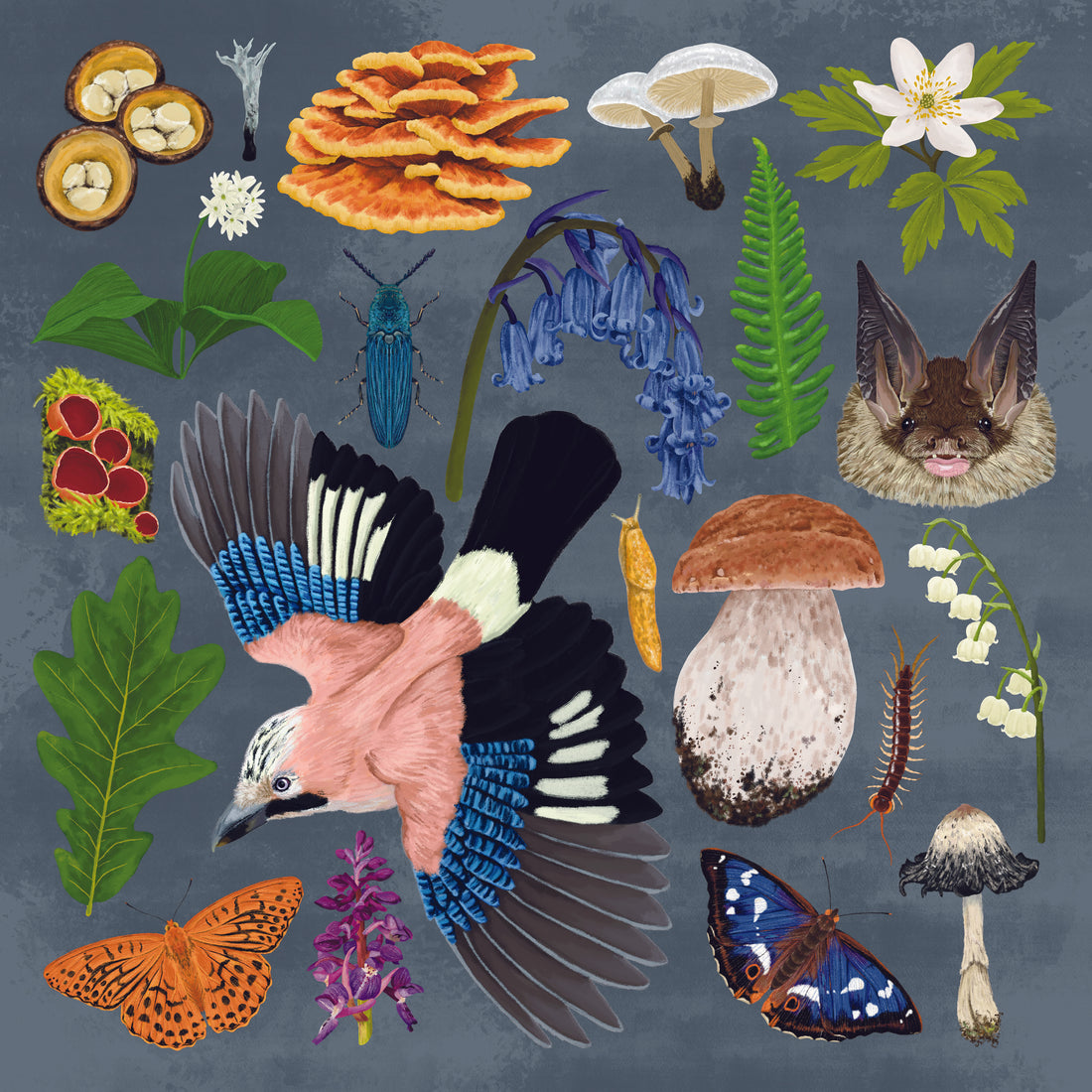
Exploring the Enchantment of Ancient Woodlands in the UK
Nestled throughout the United Kingdom, the Ancient Woodlands stand as silent witnesses to centuries of natural history and withstand human development. These woodland ecosystems, rich in biodiversity and steeped in cultural history, are a vital part of our natural heritage. In this blog, we will delve into the significance of ancient woodlands, their protection and identification, and the magical wildlife that inhabits them, which I captured through illustration.
Why are Ancient Woodlands Important?
Ancient woodlands are more than just clusters of trees; these woodlands have evolved over centuries, forming complex ecosystems that support a remarkable diversity of life. They have Centuries of undisturbed soil with nutrients from decaying wood that have created a unique yet perfect environment for rare and threatened species to live in. From fungi, insects, rare plants, birds, and mammals, ancient woodlands are home to more threatened species than anywhere else in the UK.
Beyond their ecological value, these woodlands hold immense cultural significance, retaining archaeological features of past management when we used these trees for food, shelter, and fuel. You can see this in 'coppiced trees', where they have been cut down to ground level and new growth appears in multiple new stems. These woodlands are living remnants of our past and are often intertwined with folklore, myth, one of which is that of fairies, which have many woodland stories, such as causing you to trip and putting obstructions like sticks and stones on paths, and are believed to live in rotting tree stumps.

Who Designates Ancient Woodland and How Is It Protected?
Designating a woodland as ancient is not arbitrary; it requires careful assessment by conservation bodies like Natural England, Natural Resources Wales, Scottish Natural Heritage, and the Northern Ireland Environment Agency. Ancient woodland status is bestowed upon woodlands that have existed and been continuously wooded since at least 1600 AD in England and Wales, or 1750 AD in Scotland. It starts at this point, as this is when maps started to become more accurate. These designations come with legal protections, safeguarding them from development and ensuring their preservation for future generations.
Technically, any native habitat could be ancient, and we classify ancient woodland into different categories:
Ancient semi-natural woods: These woods have developed naturally over 400 years and are often managed by humans in industries like timber.
Plantations on ancient woodland sites: These woodlands have been felled and replanted with non-native species, usually conifers or non-native beech, red oak, and sweet chestnut. These are remnants of the woodland that still have complex soil and are often being managed to return them to native woodlands.

Male Purple Emperor Butterfly: Both sexes feed from oak sap and favour these trees for their dense folliage so Males establish territories at the top of the trees.
How to Identify Ancient Woodland?
Across the UK, many but not all of the ancient woodlands have also been mapped in an 'ancient woodland inventory' with evidence on why they are believed to be classified as ancient. The presence of ancient woodland indicator species (AWIs) can help identify if a woodland is ancient; these can include plants, lichens, insects (in particular those associated with decaying wood), and slugs and snails. They also often boast a diverse array of tree species, including oak, ash, and beech. Indicator species vary in different parts of the UK, but the more of these species found in a wood, the more likely it is to be ancient. Indicator species can include English Bluebells, Wild Garlic, Lemon Slug and Barnacle lichen.

Common Bird’s Nest Fungus, Candlesnuff Fungus, Chicken of the Woods, Porcelain Fungus, Wood Anemone, Wild Garlic, Violet Click Beetle, English Bluebell, Hard Fern, Brown Long Eared Bat, Scarlet Elf Cup, Oak, Eurasian Jay, Lemon Slug, Penny Bun, Common Centipede, Lily of the Valley, Silver Washed Fratillary, Early Purple Orchid, Purple Emperor, Common Inkcap
One of the most captivating ways I personally find to celebrate the wonders of the natural world is through art. Wildlife illustrations, like this ancient woodland piece I drew, offer a glimpse into the enchanting world of these ecosystems. Featuring indicator species such as wild garlic, bluebells, jays, anemones, and fungi, this illustration beautifully captures the essence of ancient woodlands. Through art, we can foster appreciation and awareness of these vital habitats, inspiring others to join in their conservation efforts.
Prints of my Ancient Woodland piece can be found here
